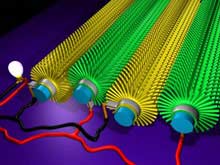Researchers have developed a microfibre fabric that could be used to generate power from the tiniest vibrations.
If made into a shirt or similar article of clothing, the fabric could harvest power from airflow, footsteps and even heartbeats, said three researchers from the Georgia Institute of Technology, who described the process of creating the fabric in the Thursday issue of the journal Nature.
"The fibre-based nanogenerator would be a simple and economical way to harvest energy from the physical movement," said Zhong Lin Wang of the university's school of materials science and engineering, in a statement.
To create the tiny generator, the researchers grew zinc oxide nanowires — wires 1,000 times smaller than the width of a human hair — in a layer embedded on textile fibres.
The textile fibres were then entwined into pairs, with one of the nanowire-coated fibres also coated with a thin layer of gold so it would act as an electrode, while the other was left as is.
As the nanowires from the gold-coated fibre rubbed against the nanowires from the uncoated fibre — in response to friction from external forces — it converts mechanical energy into electricity, the researchers said.
"The two fibres scrub together just like two bottle brushes with their bristles touching, and the ... process converts the mechanical motion into electrical energy," Wang said. "Many of these devices could be put together to produce higher power output."
Testing of a prototype showed that most of the nanowires remained fastened to the fibres, even after 30 minutes of continuous brushing. The power generation also works at low frequencies, meaning vibrations from sources such as heartbeats could be harnessed, they said.
So far the experiment has only been tested with pairs of fibres. the researchers said the next step would be to combine multiple fibre pairs to increase the current and voltage levels.
Washing a shirt made of the material is also a practical roadblock, the researchers admit, as zinc oxide is sensitive to moisture. Wang said in a statement the nanowires would need to be coated with yet another material to protect them before the fabric was put in the laundry.

